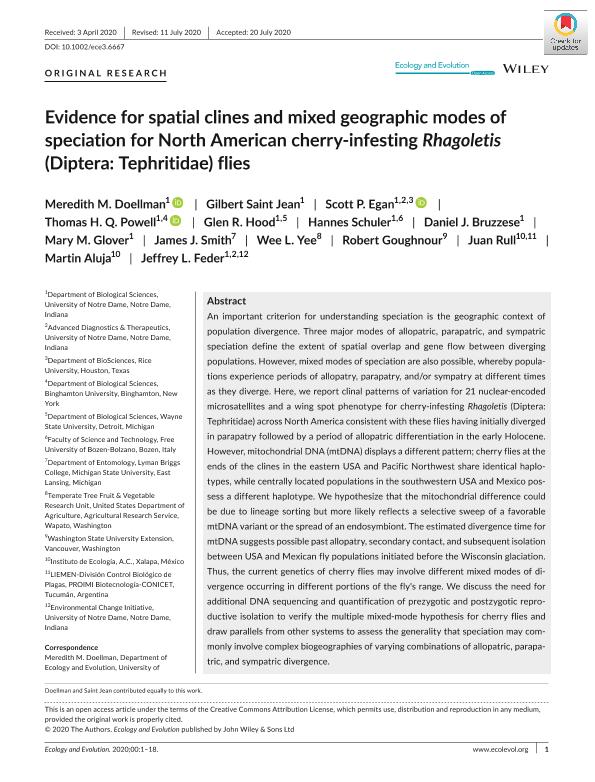Mostrar el registro sencillo del ítem
dc.contributor.author
Meredith, Michael

dc.contributor.author
Saint Jean, Gilbert
dc.contributor.author
Egan, Scott P.
dc.contributor.author
Powell, Thomas H. Q.
dc.contributor.author
Hood, Glen R.
dc.contributor.author
Schuler, Hannes
dc.contributor.author
Bruzzese, Daniel J.
dc.contributor.author
Glover, Mary M.
dc.contributor.author
Smith, James J.
dc.contributor.author
Yee, Wee L.
dc.contributor.author
Goughnour, Robert
dc.contributor.author
Rull Gabayet, Juan Antonio

dc.contributor.author
Aluja, Martin
dc.contributor.author
Feder, Jeffrey L.
dc.date.available
2021-02-26T15:20:09Z
dc.date.issued
2020-12
dc.identifier.citation
Meredith, Michael; Saint Jean, Gilbert; Egan, Scott P.; Powell, Thomas H. Q.; Hood, Glen R.; et al.; Evidence for spatial clines and mixed geographic modes of speciation for North American cherry-infesting Rhagoletis (Diptera: Tephritidae) flies; John Wiley and Sons Ltd; Ecology and Evolution; 10; 23; 12-2020; 12727-12744
dc.identifier.issn
2045-7758
dc.identifier.uri
http://hdl.handle.net/11336/126773
dc.description.abstract
An important criterion for understanding speciation is the geographic context of population divergence. Three major modes of allopatric, parapatric, and sympatric speciation define the extent of spatial overlap and gene flow between diverging populations. However, mixed modes of speciation are also possible, whereby populations experience periods of allopatry, parapatry, and/or sympatry at different times as they diverge. Here, we report clinal patterns of variation for 21 nuclear-encoded microsatellites and a wing spot phenotype for cherry-infesting Rhagoletis (Diptera: Tephritidae) across North America consistent with these flies having initially diverged in parapatry followed by a period of allopatric differentiation in the early Holocene. However, mitochondrial DNA (mtDNA) displays a different pattern; cherry flies at the ends of the clines in the eastern USA and Pacific Northwest share identical haplotypes, while centrally located populations in the southwestern USA and Mexico possess a different haplotype. We hypothesize that the mitochondrial difference could be due to lineage sorting but more likely reflects a selective sweep of a favorable mtDNA variant or the spread of an endosymbiont. The estimated divergence time for mtDNA suggests possible past allopatry, secondary contact, and subsequent isolation between USA and Mexican fly populations initiated before the Wisconsin glaciation. Thus, the current genetics of cherry flies may involve different mixed modes of divergence occurring in different portions of the fly's range. We discuss the need for additional DNA sequencing and quantification of prezygotic and postzygotic reproductive isolation to verify the multiple mixed-mode hypothesis for cherry flies and draw parallels from other systems to assess the generality that speciation may commonly involve complex biogeographies of varying combinations of allopatric, parapatric, and sympatric divergence.
dc.format
application/pdf
dc.language.iso
eng
dc.publisher
John Wiley and Sons Ltd

dc.rights
info:eu-repo/semantics/openAccess
dc.rights.uri
https://creativecommons.org/licenses/by/2.5/ar/
dc.subject
ALLOPATRY
dc.subject
CLIMATE CHANGE
dc.subject
ISOLATION BY DISTANCE
dc.subject
MICROSATELLITES
dc.subject
MTDNA
dc.subject
RANGE FRAGMENTATION
dc.subject
RHAGOLETIS CINGULATA
dc.subject
RHAGOLETIS INDIFFERENS
dc.subject
WING SPOT
dc.subject.classification
Zoología, Ornitología, Entomología, Etología

dc.subject.classification
Ciencias Biológicas

dc.subject.classification
CIENCIAS NATURALES Y EXACTAS

dc.title
Evidence for spatial clines and mixed geographic modes of speciation for North American cherry-infesting Rhagoletis (Diptera: Tephritidae) flies
dc.type
info:eu-repo/semantics/article
dc.type
info:ar-repo/semantics/artículo
dc.type
info:eu-repo/semantics/publishedVersion
dc.date.updated
2020-12-04T18:36:42Z
dc.journal.volume
10
dc.journal.number
23
dc.journal.pagination
12727-12744
dc.journal.pais
Estados Unidos

dc.journal.ciudad
Chicago
dc.description.fil
Fil: Meredith, Michael. University of Notre Dame-Indiana; Estados Unidos
dc.description.fil
Fil: Saint Jean, Gilbert. University of Notre Dame-Indiana; Estados Unidos
dc.description.fil
Fil: Egan, Scott P.. Rice University; Estados Unidos
dc.description.fil
Fil: Powell, Thomas H. Q.. University of Notre Dame-Indiana; Estados Unidos
dc.description.fil
Fil: Hood, Glen R.. University of Notre Dame-Indiana; Estados Unidos
dc.description.fil
Fil: Schuler, Hannes. University of Notre Dame-Indiana; Estados Unidos
dc.description.fil
Fil: Bruzzese, Daniel J.. University of Notre Dame-Indiana; Estados Unidos
dc.description.fil
Fil: Glover, Mary M.. University of Notre Dame-Indiana; Estados Unidos
dc.description.fil
Fil: Smith, James J.. Michigan State University; Estados Unidos
dc.description.fil
Fil: Yee, Wee L.. Usda-ars; Estados Unidos
dc.description.fil
Fil: Goughnour, Robert. United States Department of Agriculture. Agricultural Research Service; Argentina
dc.description.fil
Fil: Rull Gabayet, Juan Antonio. Consejo Nacional de Investigaciones Científicas y Técnicas. Centro Científico Tecnológico Conicet - Tucumán. Planta Piloto de Procesos Industriales Microbiológicos; Argentina
dc.description.fil
Fil: Aluja, Martin. Instituto de Ecología A.c.; México
dc.description.fil
Fil: Feder, Jeffrey L.. University of Notre Dame-Indiana; Estados Unidos
dc.journal.title
Ecology and Evolution
dc.relation.alternativeid
info:eu-repo/semantics/altIdentifier/url/https://onlinelibrary.wiley.com/doi/10.1002/ece3.6667
dc.relation.alternativeid
info:eu-repo/semantics/altIdentifier/doi/https://dx.doi.org/10.1002/ece3.6667
Archivos asociados
